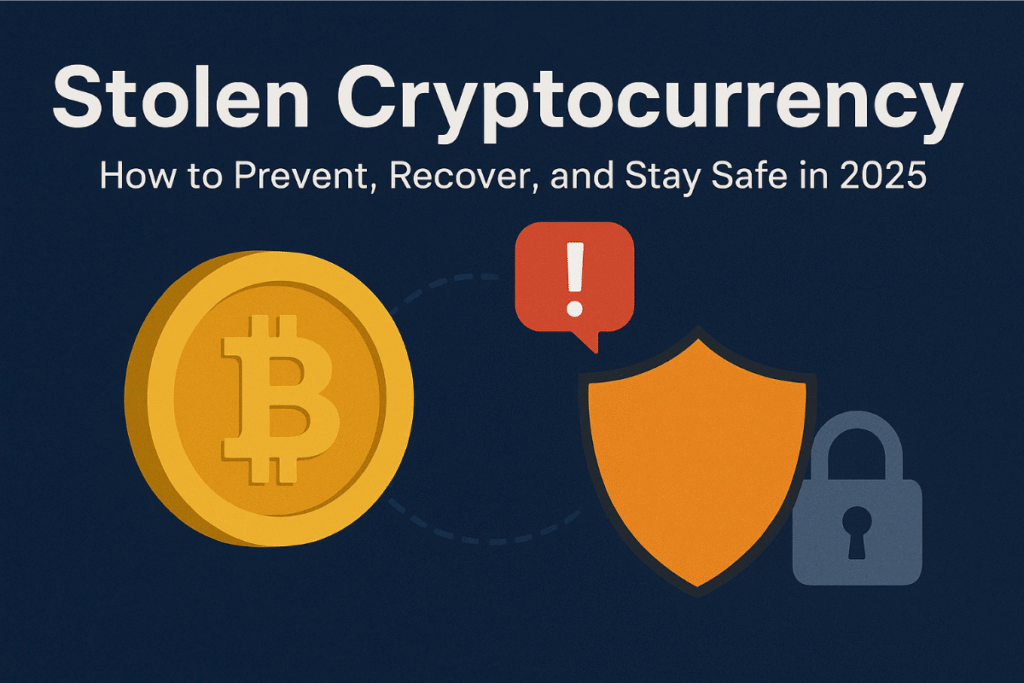Introduction
The rise of cryptocurrency has brought immense opportunities for investors, traders, and businesses worldwide. But alongside the benefits comes a growing threat stolen cryptocurrency. Every year, billions of dollars worth of digital assets stolen through hacks, phishing scams, and fraudulent schemes.
If you’ve ever wondered:
- What happens if my crypto gets stolen?
- Can stolen cryptocurrency be recovered?
- How do I prevent crypto theft?
This guide will give you a clear, step-by-step understanding of everything you need to know about stolen cryptocurrency — prevention, recovery, and safety measures.
What is Stolen Cryptocurrency?
Simply put, stolen cryptocurrency refers to digital assets that have been illegally taken from a wallet, exchange, or investor without their consent. Unlike traditional money in banks, cryptocurrency transactions decentralized and irreversible, making recovery more challenging.
Common Methods of Crypto Theft
Cybercriminals use several tactics to steal digital assets:
- Phishing Attacks – Fake emails, websites, or apps tricking users into sharing private keys.
- Exchange Hacks – Attackers break into centralized exchanges and drain wallets.
- Malware & Keyloggers – Malicious software that records keystrokes or gains access to devices.
- SIM-Swapping – Hijacking phone numbers to bypass 2FA security.
- Rug Pulls & Scams – Fraudulent projects vanish after collecting investor funds.
Why Stolen Cryptocurrency is Hard to Recover
Unlike bank transactions, crypto transfers recorded on a blockchain. While this provides transparency, it also means:
- No Central Authority – There’s no “bank manager” to reverse the transaction.
- Anonymity – Hackers often hide behind pseudonymous addresses.
- Cross-Border Issues – Funds may move across multiple countries, complicating legal action.
What to Do If Your Cryptocurrency is Stolen
If you discover your cryptocurrency has been stolen, act quickly with these steps:
1. Document Everything
- Take screenshots of transactions.
- Record wallet addresses involved.
- Save emails/messages related to the theft.
2. Contact the Exchange or Wallet Provider
If your funds stolen from a centralized exchange or hot wallet, report it immediately. Some exchanges can freeze suspicious accounts.
3. Report to Authorities
- File a complaint with local police or cybercrime units.
- In the U.S., report to the FBI’s Internet Crime Complaint Center (IC3).
- In the EU, report to Europol’s Cybercrime Division.
4. Use Blockchain Tracking Tools
Companies like Chainalysis, CipherTrace, and Elliptic specialize in tracing stolen funds across blockchain transactions.
5. Hire a Recovery Service (Carefully)
Some professional firms claim to recover stolen crypto, but many are scams themselves. Only work with reputable, verified companies.
How to Prevent Cryptocurrency Theft
The best protection is prevention. Here’s how to safeguard your digital assets:
1. Use a Hardware Wallet
Cold wallets (Ledger, Trezor) store keys offline, safe from hackers.
2. Enable Two-Factor Authentication (2FA)
Always enable 2FA on exchanges and wallets, preferably using apps like Google Authenticator rather than SMS.
3. Avoid Public Wi-Fi
Hackers can intercept transactions on unsecured networks. Use a VPN for added safety.
4. Double-Check URLs & Apps
Phishing websites often mimic real crypto platforms. Bookmark the official sites to avoid mistakes.
5. Diversify Storage
Don’t keep all funds on one platform. Spread across multiple wallets.
6. Regular Software Updates
Update your wallet apps, devices, and antivirus regularly to avoid vulnerabilities.
Legal Aspects of Stolen Cryptocurrency
The legality of stolen cryptocurrency varies across countries. Some key points:
- Property Classification – In many jurisdictions, cryptocurrencies considered assets, making theft a criminal act.
- Law Enforcement Cooperation – Authorities often work with blockchain analytics companies to track stolen funds.
- Court Cases – Victims can file lawsuits to reclaim funds if the thief identified.
However, since laws are still evolving, not every stolen crypto case can be resolved legally.
Case Studies: Famous Cryptocurrency Thefts
1. Mt. Gox Hack (2014)
Over 850,000 BTC were stolen, one of the largest crypto heists in history.
2. Poly Network Hack (2021)
$610 million worth of crypto was stolen, but surprisingly, most funds were later returned.
3. FTX Collapse (2022)
Though not a hack, billions of dollars in customer funds were misused, leading to massive losses.
Best Practices to Stay Safe in 2025
- Multi-Signature Wallets – Require multiple approvals for transactions.
- Cold Storage for Large Funds – Only keep small amounts in hot wallets.
- Insurance Options – Some exchanges now offer insurance against hacks.
- Education & Awareness – Stay updated on the latest crypto scams and threats.
FAQs About Stolen Cryptocurrency
Q1. Can stolen cryptocurrency be recovered?
Recovery is difficult but possible with blockchain forensics and legal action. Success depends on speed and cooperation with authorities.
Q2. What should I do immediately if my crypto is stolen?
Document details, contact the exchange, report to authorities, and seek blockchain tracing services.
Q3. Are crypto recovery services legit?
Some are genuine, but many are scams. Always research before hiring.
Q4. How do hackers usually steal cryptocurrency?
Through phishing, malware, SIM-swapping, exchange hacks, and fraudulent projects.
Q5. Which wallets are the safest?
Hardware wallets like Ledger and Trezor are the most secure options.
Conclusion
The threat of stolen cryptocurrency is real and growing, but with the right preventive measures, you can protect your digital wealth. Remember:
- Use hardware wallets for maximum safety
- Stay alert for scams and phishing attacks
- Act quickly if theft occurs
- Report and document every detail
As cryptocurrencies continue to shape the financial future, staying informed and secure is your best defense.
Protect your crypto, protect your future.



